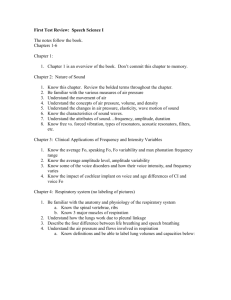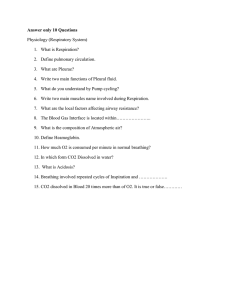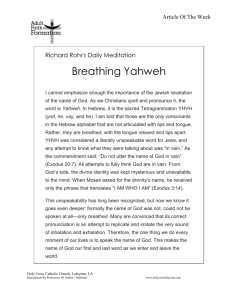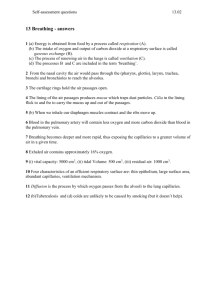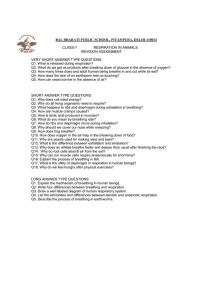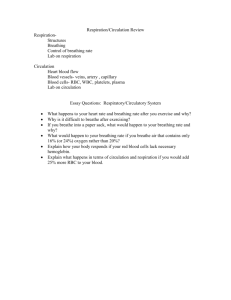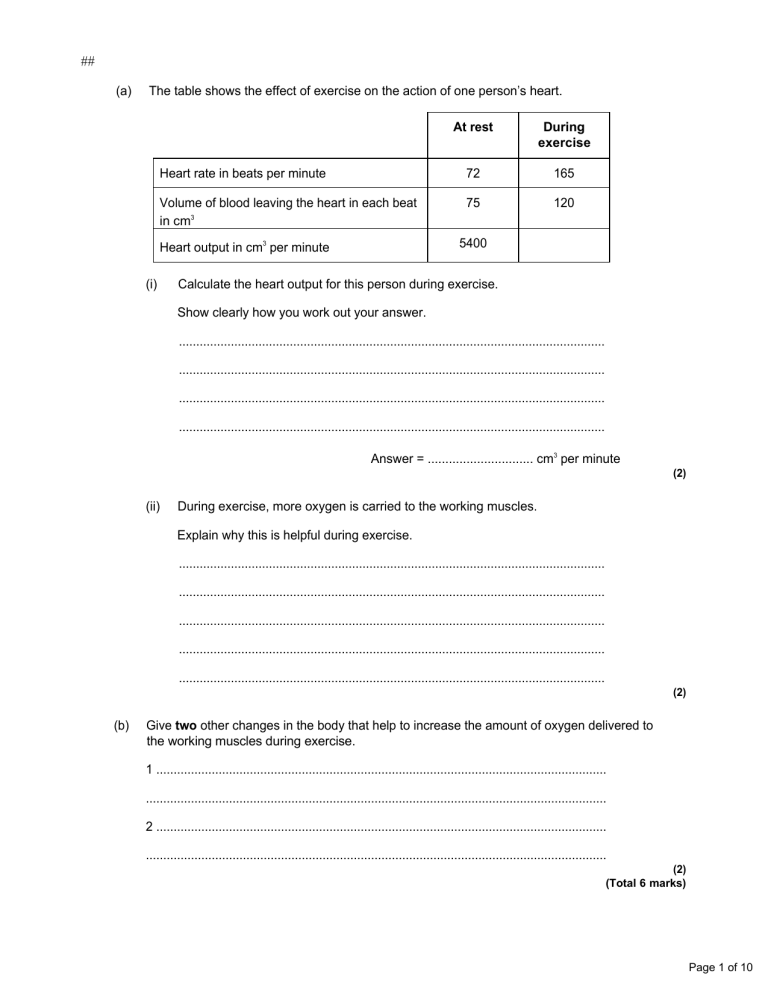
## (a) The table shows the effect of exercise on the action of one person’s heart. At rest During exercise Heart rate in beats per minute 72 165 Volume of blood leaving the heart in each beat in cm3 75 120 5400 Heart output in cm3 per minute (i) Calculate the heart output for this person during exercise. Show clearly how you work out your answer. ........................................................................................................................... ........................................................................................................................... ........................................................................................................................... ........................................................................................................................... Answer = .............................. cm3 per minute (2) (ii) During exercise, more oxygen is carried to the working muscles. Explain why this is helpful during exercise. ........................................................................................................................... ........................................................................................................................... ........................................................................................................................... ........................................................................................................................... ........................................................................................................................... (2) (b) Give two other changes in the body that help to increase the amount of oxygen delivered to the working muscles during exercise. 1 .................................................................................................................................. ..................................................................................................................................... 2 .................................................................................................................................. ..................................................................................................................................... (2) (Total 6 marks) Page 1 of 10 Q2. Paula is training for a marathon. When she runs, her heart beats faster than it does when she is resting. Complete the sentences, using words from the box. blood breathe heat nitrogen carbon dioxide oxygen glucose respire When she is running, Paula‘s muscle activity increases. To do this, her muscle cells ................................................. at a faster rate to give her more energy. Her muscles need to be supplied with ........................................... and .................................................................... more quickly. Her heart beats faster to increase the flow of.................................................... which carries the products ................................................................................................ and ............................................................ away from her muscles. (Total 6 marks) Page 2 of 10 Q3. A student‘s breathing was monitored before and after vigorous exercise. The student breathed in and out through a special apparatus. The graphs show the changes in the volume of air inside the apparatus. Each time the student breathed in, the line on the graph dropped. Each time the student breathed out, the line went up. Page 3 of 10 (a) How many times did the student breathe in per minute: before exercise; ........................................................................................................... after exercise? ............................................................................................................. (1) (b) On each graph, the line A – B shows how much oxygen was used. The rate of oxygen use before exercise was 0.5 dm3 per minute. Calculate the rate of oxygen use after exercise. ..................................................................................................................................... ..................................................................................................................................... ..................................................................................................................................... Rate of oxygen use after exercise = ................................................. dm3 per minute (2) (c) The breathing rate and the amount of oxygen used were still higher after exercise, even though the student sat down to rest. Why were they still higher? ..................................................................................................................................... ..................................................................................................................................... ..................................................................................................................................... ..................................................................................................................................... ..................................................................................................................................... ..................................................................................................................................... ..................................................................................................................................... (4) (Total 7 marks) Page 4 of 10 Q4. A student breathed out into an empty breathing bag five times. After breathing out five times the volume of air in the bag was measured. The volume was 3000 cm3. (a) Complete the following sentences. The air the student breathed in would contain more ........................................ than the air the student breathed out. The air the student breathed out would contain more ...................................... than the air the student breathed in. (2) (b) The student then did some exercise for two minutes. The volume breathed out in five breaths was again measured. This time there was 9000 cm3 of air in the bag. What does this tell you about the effect of exercise on breathing? ..................................................................................................................................... ..................................................................................................................................... (1) (c) (i) Name the chemical process that releases energy when it takes place in the cells of the body. ................................................ (1) (ii) Name the substances produced by this process. .......................................................... and .......................................................... (2) Page 5 of 10 (iii) Explain as fully as you can why this process has to take place more rapidly during exercise. ........................................................................................................................... ........................................................................................................................... ........................................................................................................................... ........................................................................................................................... (2) (Total 8 marks) Page 6 of 10 M1. (a) (i) 19 800 for correct answer ignore working or lack of working 165 × 120 but no answer / wrong answer = 1 mark (ignore extras) 2 (ii) any two from: • for respiration ignore oxygen debt • energy released allow energy produced • prevents anaerobic respiration • prevents build-up of lactic acid 2 (b) any two from: • increased breathing rate(*) • increased depth of breathing or deep breathing(*) (*)more breathing is max 1 mark ignore increase in heart rate allow heavier breathing do not allow harder breathing • dilation of arteries / vasodilation allow blood vessels dilate do not allow veins / capillaries dilate • blood diverted from elsewhere ignore name of organ 2 [6] Page 7 of 10 M2. (a) respire 1 2 blood 1 2 [6] M3. (a) (before exercise) – 9 to 11 and (after exercise) – 12 or 13 both correct 1 (b) 0.75 to 0.90 ignore working or lack of working eg. 2.35 – 1.55 or for 1 mark or other suitable figures 2 (c) any four from: still need to remove extra carbon dioxide still need to remove heat / to cool (some) anaerobic respiration (in exercise) lactic acid made (in exercise) oxygen needed to break down lactic acid or suitable reference to oxygen debt lactic acid broken down to CO2 and water or lactic acid changed into glucose 4 [7] ## (a) oxygen, carbon dioxide or water (vapour) for 1 mark each 2 Page 8 of 10 (b) idea of more air per breath/deeper breaths for 1 mark 1 (c) (i) respiration for 1 mark 1 (ii) carbon dioxide, water for 1 mark each 2 (iii) more energy required, for increased muscular activity for 1 mark each 2 [8] Page 9 of 10 Page 10 of 10
